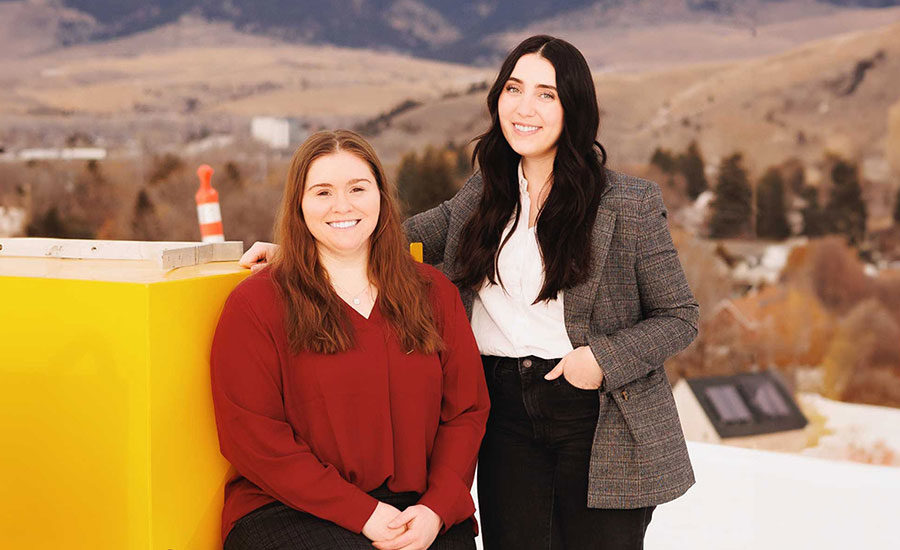Science
RFK Jr. speaks candidly about his gravelly voice: ‘If I could sound better, I would’

There was a time before the turn of the millennium when Robert F. Kennedy Jr. gave a full-throated accounting of himself and the things he cared about. He recalls his voice then as “unusually strong,” so much so that he could fill large auditoriums with his words. No amplification needed.
The independent presidential candidate recounts those times somewhat wistfully, telling interviewers that he “can’t stand” the sound of his voice today — sometimes choked, halting and slightly tremulous.
The cause of RFK Jr.’s vocal distress? Spasmodic dysphonia, a rare neurological condition, in which an abnormality in the brain’s neural network results in involuntary spasms of the muscles that open or close the vocal cords.
My voice doesn’t really get tired. It just sounds terrible.
— Robert F. Kennedy Jr.
“I feel sorry for the people who have to listen to me,” Kennedy said in a phone interview with The Times, his voice as strained as it sounds in his public appearances. “My voice doesn’t really get tired. It just sounds terrible. But the injury is neurological, so actually the more I use the voice the stronger it tends to get.”
Since declaring his bid for the presidency a year ago, the 70-year-old environmental lawyer has discussed his frayed voice only on occasion, usually when asked by a reporter. He told The Times: “If I could sound better, I would.”
SD, as it’s known, affects about 50,000 people in North America, although that estimate may be off because of undiagnosed and misdiagnosed cases, according to Dysphonia International, a nonprofit that organizes support groups and funds research.
As with Kennedy, cases typically arise in midlife, though increased recognition of SD has led to more people being diagnosed at younger ages. The disorder, also known as laryngeal dystonia, hits women more often than men.
Internet searches for the condition have spiked, as Kennedy and his gravelly voice have become staples on the news. When Dysphonia International posted an article answering the query, “What is wrong with RFK Jr.’s voice?,” it got at least 10 times the traffic of other items.
Those with SD usually have healthy vocal cords. Because of this, and the fact that it makes some people sound like they are on the verge of tears, some doctors once believed that the croaking or breathy vocalizations were tied to psychological trauma. They often prescribed treatment by a psychotherapist.
But in the early 1980s, researchers, including Dr. Herbert Dedo of UC San Francisco, recognized that SD was a condition rooted in the brain.
Researchers have not been able to find the cause or causes of the disorder. There is speculation that a genetic predisposition might be set off by some event — physical or emotional — that triggers a change in neural networks.
Some who live with SD say the spasms came out of the blue, seemingly unconnected to other events, while others report that it followed an emotionally devastating personal setback, an injury accident or a severe infection.
Kennedy said he was teaching at Pace University School of Law in White Plains, N.Y., in 1996 when he noticed a problem with his voice. He was 42.
His campaigns for clean water and other causes in those days meant that he traveled the country, sometimes appearing in court or giving speeches. He lectured, of course, in his law school classes and co-hosted a radio show. Asked whether it was hard to hear his voice gradually devolve, Kennedy said: “I would say it was ironic, because I made my living on my voice.”
“For years people asked me if I had any trauma at that time,” he said. “My life was a series of traumas … so there was nothing in particular that stood out.”
Kennedy was just approaching his 10th birthday when his uncle, President John F. Kennedy, was assassinated. At 14, his father was fatally shot in Los Angeles, on the night he won California’s 1968 Democratic primary for president.
RFK Jr. also lost two younger brothers: David died at age 28 of a heroin overdose in 1984 and Michael died in 1997 in a skiing accident in Aspen, Colo., while on the slopes with family members, including then-43-year-old RFK Jr.
It was much more recently, and two decades after the speech disorder cropped up, that Kennedy came up with a theory about a possible cause. Like many of his highly controversial and oft-debunked pronouncements in recent years, it involved a familiar culprit — a vaccine.
Kennedy said that while he was preparing litigation against the makers of flu vaccines in 2016, his research led him to the written inserts that manufacturers package along with the medications. He said he saw spasmodic dysphonia on a long list of possible side effects. “That was the first I ever realized that,” he said.
Although he acknowledged there is no proof of a connection between the flu vaccines he once received annually and SD, he told The Times he continues to view the flu vaccine as “at least a potential culprit.”
Kennedy said he no longer has the flu vaccine paperwork that triggered his suspicion, but his campaign forwarded a written disclosure for a later flu vaccine. The 24-page document lists commonly recognized adverse reactions, including pain, swelling, muscle aches and fever.
It also lists dozens of less common reactions that users said they experienced. “Dysphonia” is on the list, though the paperwork adds that “it is not always possible to reliably estimate their frequency or establish a causal relationship to the vaccine.”
Public health experts have slammed Kennedy and his anti-vaccine group, Children’s Health Defense, for advancing unsubstantiated claims, including that vaccines cause autism and that COVID-19 vaccines caused a spike of sudden deaths among healthy young people.
Dr. Timothy Brewer, a professor of medicine and epidemiology at UCLA, said an additional study cited by the Kennedy campaign to The Times referred to reported adverse reactions that were unverified and extremely rare.
“We shouldn’t minimize risks or overstate them,” Brewer said. “With these influenza vaccines there are real benefits that so far outweigh the potential harm cited here that it’s not worth considering those types of reactions further.”
Anyone with concerns about influenza vaccine side effects should consult their physician, he said.
So what does research suggest about SD?
“We just don’t know what brings it on,” said Dr. Michael Johns, director of the USC Voice Center and an authority on spasmodic dysphonia. “Intubation, emotional trauma, physical trauma, infections and vaccinations are all things that are incredibly common. And it’s very hard to pin causation on something that is so common when this is a condition that is so rare.”
No two SD sufferers sound the same. For some, spasms push the vocal cords too far apart, causing breathy and nearly inaudible speech. For others, such as Kennedy, the larynx muscles push the vocal cords closer together, creating a strained or strangled delivery.
“I would say it was a very, very slow progression,” Kennedy said last week. “I think my voice was getting worse and worse.”
There were times when mornings were especially difficult.
“When I opened my mouth, I would have no idea what would come out, if anything,” he said.
One of the most common treatments for the disorder is injecting Botox into the muscles that bring the vocal cords together.
Kennedy said he received Botox injections every three or four months for about 10 years. But he called the treatment “not a good fit for me,” because he was “super sensitive to the Botox.” He recalled losing his voice entirely after the injections, before it would return days later, somewhat smoother.
Looking for a surgical solution, Kennedy traveled to Japan in May, 2022. Surgeons in Kyoto implanted a titanium bridge between his vocal cords (also known as vocal folds) to keep them from pressing together.
He told a YouTube interviewer last year that his voice was getting “better and better,” an improvement he credited to the surgery and to alternative therapies, including chiropractic care.
The procedure has not been approved by regulators in the U.S.
Johns cautioned that titanium bridge surgeries haven’t been consistently effective or durable and said there have been reports of the devices fracturing, despite being implanted by reputable doctors. He suggested that the more promising avenue for breakthroughs will be in treating the “primary condition, which is in the brain.”
Researchers are now trying to find the locations in the brain that send faulty signals to the larynx. Once those neural centers are located, doctors might use deep stimulation — like a pacemaker for the brain — to block the abnormal signals that cause vocal spasms. (Deep brain stimulation is used to treat patients with Parkinson’s disease and other afflictions.)
Long and grueling presidential campaigns have stolen the voice of many candidates. But Kennedy said he is not concerned, since his condition is based on a neural disturbance, not one in his voice box.
“Actually, the more I use the voice, the stronger it tends to get,” he said. “It warms up when I speak.”
Kennedy was asked whether the loss of his full voice felt particularly frustrating, given his family’s legacy of ringing oratory. He replied, his voice still raspy, “Like I said, it’s ironic.”

Science
A champion of psychedelics who includes a dose of skepticism
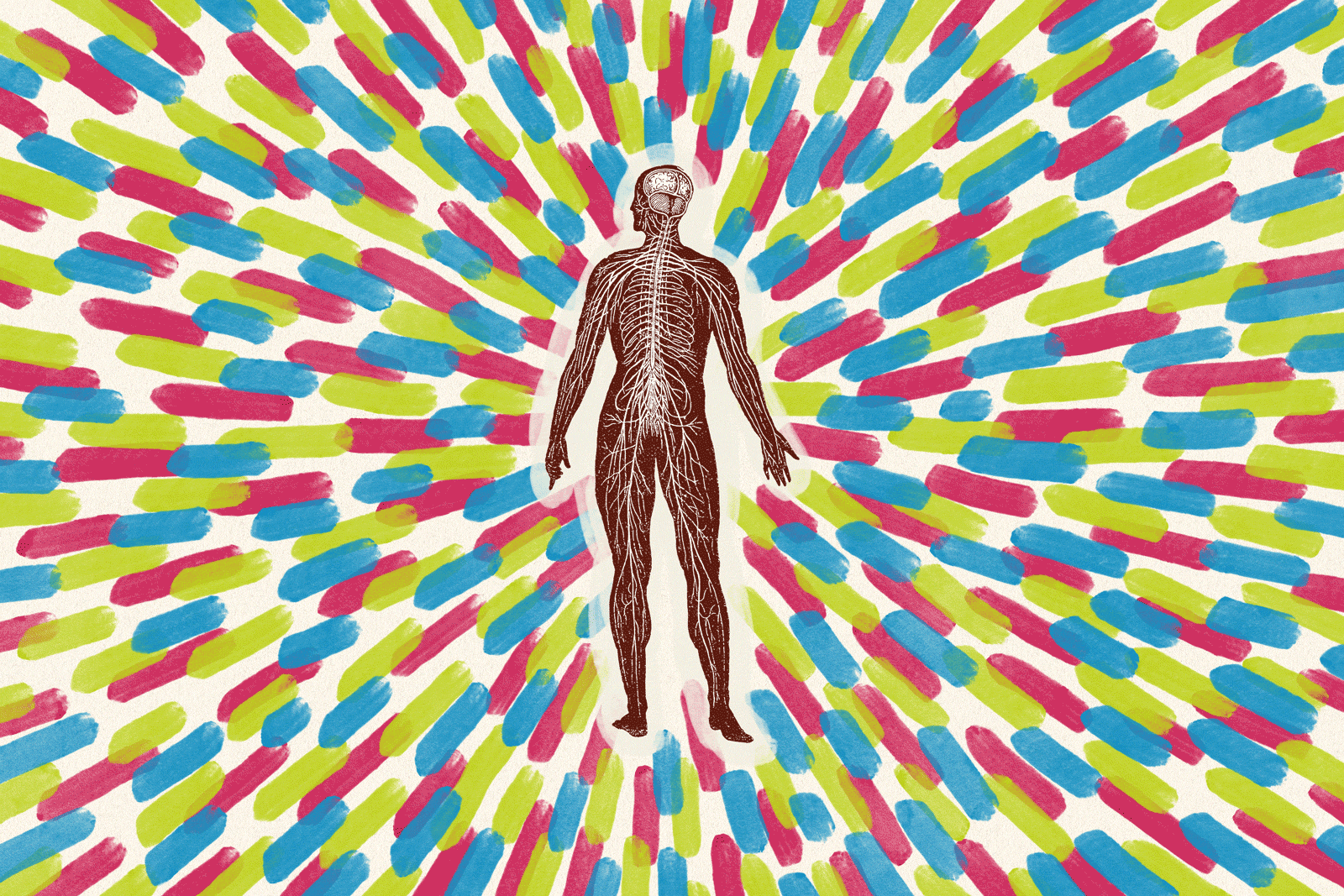
Book Review
Trippy: The Peril and Promise of Medicinal Psychedelics
By Ernesto Londoño
Celadon Books: 320 pages, $29.99
If you buy books linked on our site, The Times may earn a commission from Bookshop.org, whose fees support independent bookstores.
Ernesto Londoño’s engrossing and unsettling new book, “Trippy: The Peril and Promise of Medicinal Psychedelics,” is part memoir, part work of journalism. It tells of how Londoño sought relief from depression with mind-altering drugs. It also investigates the current fad of “medicinal” psychedelics as a treatment for those struggling with depression, trauma, suicidality and other conditions.
Like other psychedelic enthusiasts, Londoño — a journalist who reported in conflict zones such as Iraq and Afghanistan and served as the New York Times’ Brazil bureau chief — wants us to like psychedelics. They relieve him of depression and suicidality. He then continues to “trip” to engage in self-exploration: escape reality, journey into himself and return with an expanded view of the world.
Calling street drugs and hallucinogenics such as psilocybin, MDMA/ecstasy, LSD and ayahuasca “medicine” is problematic. Psychedelic psychiatry has had a resurgence in the past decade, though only among a minority of medical professionals. Mainstream psychiatry largely abandoned psychedelics by the 1970s, for a variety of reasons.
The renewed interest in psychedelics as a treatment seems to arise more from hope than science — a wish that medicinal psychedelics will be effective because our current treatments are inadequate. Antidepressants known as SSRIs and other approaches are often ineffectual, but that doesn’t mean psychedelics, which can be damaging to many in acute distress, should be tried.
Londoño is more balanced in discussing the benefits and dangers than Michael Pollan and others. Pollan’s bestselling book-turned-Netflix-series “How to Change Your Mind” proselytizes medicinal psychedelics in a way that “Trippy” thankfully doesn’t.
Londoño brings a healthy dose of skepticism. Psychedelics aren’t romanticized with examples of the counterculture movement of the 1960s or hyped by listing celebrities currently using them. The author often questions how much of what he’s part of is “a cult” and if what he’s taking is “voodoo,” not medicine.

Ernesto Londoño, author of “Trippy.”
(Jenn Ackerman)
“Trippy” is a fascinating account of the world of medicinal psychedelics. We attend psychedelic retreats in the Amazon and Latin America. We drink ayahuasca, a syrupy, foul-tasting psychoactive tea that induces vomiting and hallucinations. Ayahuasca calls back “memories” — some real, others false — that participants take as the cause of their emotional ill health.
We visit a ketamine clinic, where Londoño feels a “blissful withdrawal,” retaining “strong powers of perception” but losing “any sense of being a body with limbs that can move at will.”
We watch MDMA (a German pharmaceutical from 1912 now best known as the street drug called ecstasy or molly) being administered at a veterans hospital to treat post-traumatic stress disorder. At a “treatment center”/church/spiritual refuge in Austin, Texas, we witness tobacco being blown into a man’s nostrils, extract from an Amazonian plant squirted into his eyes, and toad venom burned into his forearms under the guise of spiritual salvation.
Unlike the unbridled enthusiasts, Londoño exposes the predatory nature of the psychedelic industry and how it exoticizes the use of hallucinogens as Indigenous medicines. We’re privy to some scandals in this field, specifically sexual abuse and harassment and taking advantage of vulnerable people looking for help.
It’s an engaging memoir of one man’s experiences with psychedelics. Londoño’s little asides, like when he’s talking about meeting the man who would become his husband, endear him to us: “I saw the profile of a handsome man visiting from Minnesota for the weekend. He was a vegetarian and veterinarian. Swoon!”
But as a work of mental health journalism, “Trippy” isn’t, as the book jacket suggests, “the definitive book on psychedelics and mental health today.”
Much is overlooked and left out. Londoño fails to stress that these treatments best serve the “worried well,” those struggling with relatively mild complaints, but can be extremely unsafe for those with serious mental illness, meaning severe dysfunction. Such a person has typically been diagnosed with bipolar disorder, major depressive disorder with suicidality, post-traumatic stress or schizophrenia. They can’t hold a job or live independently, often for years.
Most people Londoño interviews in “Trippy” seek “bliss,” not lifesaving measures to give them a chance at basic functioning. The retreats are less mental health centers than gatherings of spiritual seekers.
Full disclosure: I read “Trippy” with an open mind and as someone who spent 25 years in the American mental health system with serious mental illness. Those years passed the way they do for so many: a string of hospitalizations endured, countless therapeutic modalities tried, numerous mental health professionals seen and myriad psychiatric medications taken (yes, in the double digits).
“Medicinal” psychedelics never came up as a potential treatment. I recovered before fringe psychiatry’s renewed interest in psychedelics became a fad in the past decade.
It’s unsettling that Londoño doesn’t mention the recovery movement and what we know can lead to mental health recovery. He doesn’t mention the five Ps, which are based on the four Ps that Thomas Insel, former head of the National Institute of Mental Health, writes about in “Healing: Our Path from Mental Illness to Mental Health.” To heal, we need people (social support), place (a safe home), purpose (meaning in life), payment (access to mental health care) and physical health (a clean diet and, ironically, no drugs or alcohol).
In this, Londoño fails to explore whether his recovery had as much to do with the changes he made as a result of his first treatment/trip as with psychedelics themselves: changes in diet, renewed purpose, finding love, moving into a new home, leaving his stressful job. If two centuries of psychiatric research has taught us one thing, it’s that there is no magic bullet for mental health recovery.
The book’s most compelling explorations into psychedelics as mental health treatments come when Londoño discusses their use in treating trauma, particularly that which war journalists and veterans experience.
He also explores the pervasiveness of mental health issues and the particular challenges LGBTQ+ people can face.
“Trippy” raises seminal questions we need to be asking as the psychedelic industry reaches further into mental health treatment:
What is “medicine” and what is an illicit drug?
Are we trying to treat those in crisis or simply help anyone escape the suffering that’s part of the human experience?
Should we continue to try more and more extreme treatments?
Or should we finally pay attention to and change systemic issues that are the root cause of so much mental and emotional distress?
Sarah Fay is the author of the bestselling memoirs “Pathological: The True Story of Six Misdiagnoses” and “Cured.”
Science
Maps of Two Cicada Broods, Reunited After 221 Years

This spring, two broods of cicadas will emerge in the Midwest and the Southeast, in their first dual appearance since 1803.
A cicada lays eggs in an apple twig.
“Insects: Their Ways and Means of Living,” by Robert E. Snodgrass, 1930, via the Biodiversity Heritage Library
Brood XIII, the Northern Illinois Brood, hatched and burrowed into the ground 17 years ago, in 2007.
Brood XIX, the Great Southern Brood, hatched in 2011 and has spent 13 years underground, sipping sap from tree roots.
The entomologist Charles L. Marlatt published a detailed map of Brood XIX, the largest of the 13-year cicada broods, in 1907.
Historic map of cicada emergence.
He also mapped the expected emergence of Brood XIII in 1922.
Historic map of cicada emergence.
This spring the two broods will surface together, and are expected to cover a similar range.
Modern map of cicada emergence.
Up to a trillion cicadas will rise from the warming ground to molt, sing, mate, lay eggs and die.
A Name and a Number
Charles L. Marlatt proposed using Roman numerals to identify the regional groups of 13- and 17-year periodical cicadas, beginning with Brood I in 1893.
A brood can include up to three or four cicada species, all emerging at the same time and singing different songs. Long cicada lifespans of 13 or 17 years spent underground have spawned many theories, and may have evolved to reduce the likelihood of different broods surfacing at the same time.
Large broods might sprawl across a dozen or more states, while a small brood might only span a few counties. Brood VII is the smallest, limited to a small part of New York State and at risk of disappearing.
At least two named broods are thought to have vanished: Brood XXI was last seen in 1870, and Brood XI in 1954.
Not Since the Louisiana Purchase
Brood XIII and Brood XIX will emerge together this year, for the first time in more than two centuries. But only in small patches of Illinois are they likely to come out of the ground in the same place.
In 1786 and 1790, the two broods burrowed into Native lands, divided by the Mississippi River into nominally Spanish territory and the new nation of the United States.
An historic map of the United States from 1783.
Brood XIII entered the ground in 1786, and Brood XIX in 1790. (Expected 2024 ranges are overlaid on the map.)
An historic map of the United States from 1783.
As the ground was warming in April 1803, France sold the rights to the territory of Louisiana, which it acquired from Spain in 1800, to the United States for $15 million.
An historic map of the United States from 1801. That spring, Brood XIII and Brood XIX emerged together into a newly enlarged United States.
An historic map of the United States from 1803.
Their descendants — 13 and 17 generations later — are now poised to return, and will not sing together again until 2245. An historic map of the United States from 1868.
A ‘Great Visitation’
After an emergence of Brood X cicadas in 1919, the naturalist Harry A. Allard wrote:
Although the incessant concerts of the periodical cicadas persisting from morning until night became almost disquieting at times, I felt a positive sadness when I realized that the great visitation was over, and there was silence in the world again, and all were dead that had so recently lived and filled the world with noise and movement.
It was almost a painful silence, and I could not but feel that I had lived to witness one of the great events of existence, comparable to the occurrence of a notable eclipse or the invasion of a great comet.
Then again the event marked a definite period in my life, and I could not but wonder how changed would be my surroundings, my experiences, my attitude toward life, should I live to see them occur again seventeen years later.
The transformation of a cicada nymph (1), into an adult (10).
“The Periodical Cicada,” by Charles L. Marlatt, 1907, via the Biodiversity Heritage Library
Science
What are the blue blobs washing up on SoCal beaches? Welcome to Velella velella Valhalla

The corpses are washing up by the thousands on Southern California’s beaches: a transparent ringed oval like a giant thumbprint 2 to 3 inches long, with a sail-like fin running diagonally down the length of the body.
Those only recently stranded from the sea still have their rich, cobalt-blue color, a pigment that provides both camouflage and protection from the sun’s UV rays during their life on the open ocean.
Aggressive and impactful reporting on climate change, the environment, health and science.
These intriguing creatures are Velella velella, known also as by-the-wind sailors or, in marine biology circles, “the zooplankton so nice they named it twice,” said Anya Stajner, a biological oceanography PhD student at UC San Diego’s Scripps Institution of Oceanography.
A jellyfish relative that spends the vast majority of its life on the surface of the open sea, velella move at the mercy of the wind, drifting over the ocean with no means of locomotion other than the sails atop their bodies. They tend to wash up on the U.S. West Coast in the spring, when wind conditions beach them onshore.
Springtime velella sightings documented on community science platforms like iNaturalist spiked both this year and last, though scientists say it’s too early to know if this indicates a rise in the animal’s actual numbers.
Velella are an elusive species whose vast habitat and unusual life cycle make them difficult to study. Though they were documented for the first time in 1758, we still don’t know exactly what their range is or how long they live.
These beaching events confront us with a little-understood but essential facet of marine ecology — and may become more common as the oceans warm.
“Zooplankton” — the tiny creatures at the base of the marine food chain — “are sort of this invisible group of animals in the ocean,” Stajner said. “Nobody really knows anything about them. No one really cares about them. But then during these mass Velella velella strandings, all of a sudden there’s this link to this hidden part of the ocean that most of us don’t get to experience.”
What looks like an individual Velella velella is actually a colony of teeny multicellular animals, or zooids, each with their own function, that come together to make a single organism. They’re carnivorous creatures that use stinging tentacles hanging below the surface to catch prey such as copepods, fish eggs, larval fish and smaller plankton.
Unlike their fellow hydrozoa, the Portuguese man o’ war, the toxin in their tentacles isn’t strong enough to injure humans. Nevertheless, “I wouldn’t encourage anyone to touch their mouth or their eyes after they pick one up on the beach,” said Nate Jaros, senior director of fishes and invertebrates at the Aquarium of the Pacific in Long Beach.
Velella that end their lives on California beaches typically have sails that run diagonally from left to right along the length of their bodies, an orientation that catches the onshore winds heading in this direction. As the organism’s carcass dries in the sun and the soft tissues decay, the blue color disappears, leaving the transparent chitinous float behind.
“The wind really just brings them to our doorstep in the right conditions,” Jaros said. “But they’re designed as open ocean animals. They’re not designed to interact with the shoreline, which is usually why they meet their demise when they come into contact with the shore.”
1
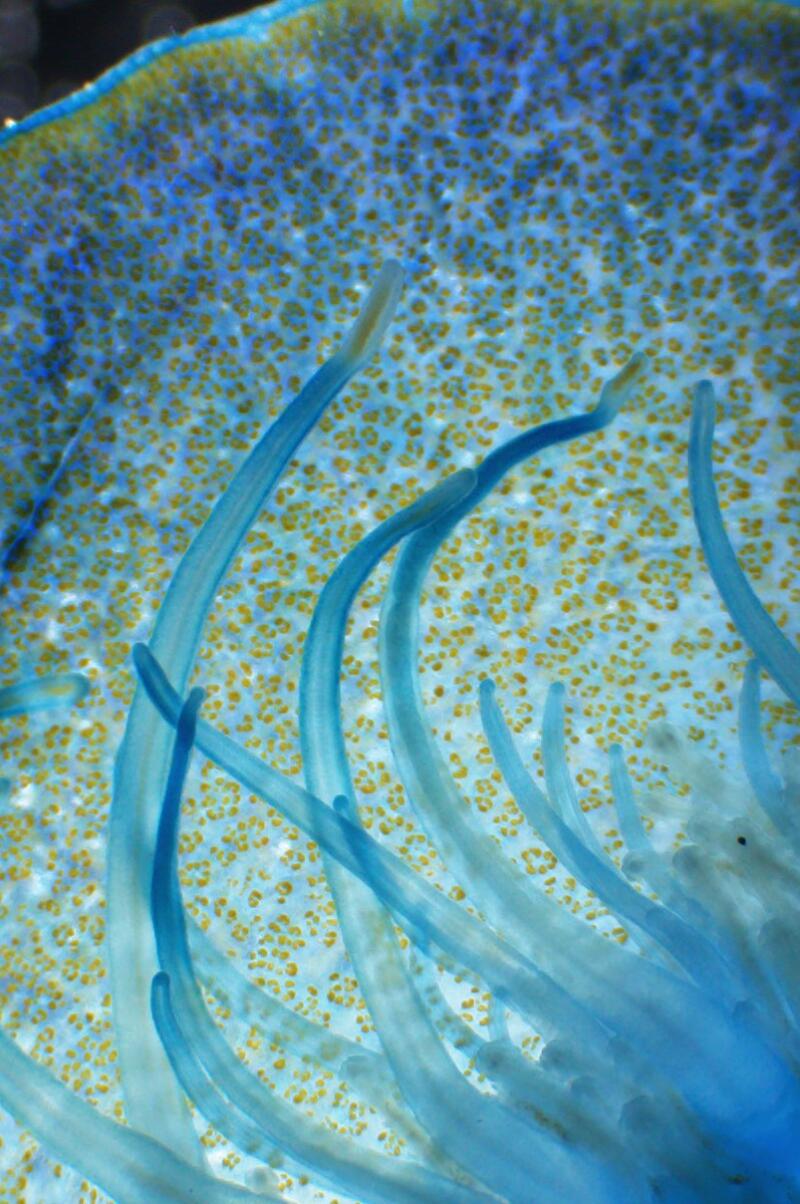
2
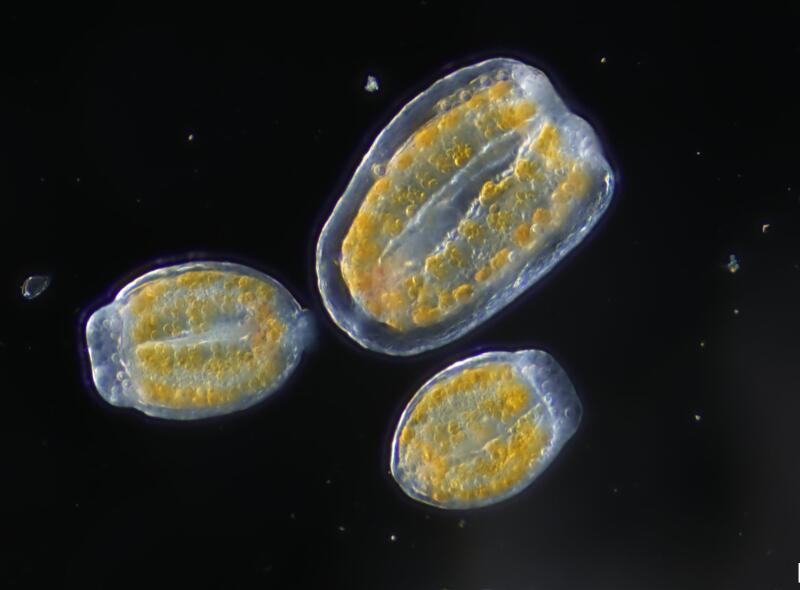
3
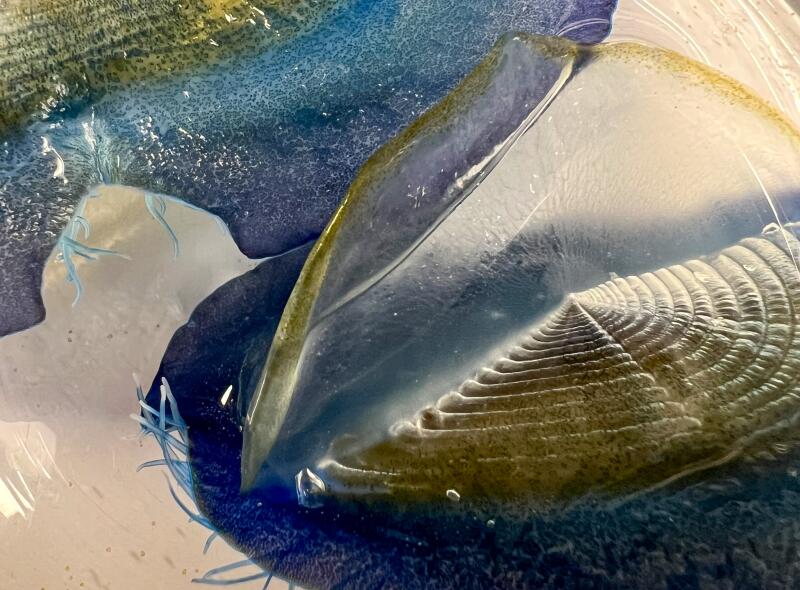
1. Anya Stajner put Velella velella under a microscope. 2. Magnified, you can see more than blue in the organism. “That green and brown coloration comes from their algae symbionts,” Stajner said. 3. Notice the tentacles too. (Anya Stajner)
Velella show up en masse when two key factors coincide, Stajner said: an upwelling of food-rich, colder water from deeper in the ocean, followed by shoreward winds and currents that direct the colonies to beaches.
A 2021 paper from researchers at the University of Washington found a third variable that appears to correlate with more velella sightings: unusually high sea surface temperatures.
After looking at data over a 20-year period, the researchers found that warmer-than-average winter sea surface temperatures followed by onshore winds tended to correlate with higher numbers of velella strandings the following spring, from Washington to Northern California.
“The spring transition toward slightly more onshore winds happens every year, but the warmer winter conditions are episodic,” said co-author Julia K. Parrish, a University of Washington biologist who runs the Coastal Observation and Seabird Survey Team community science project.
Given that sea surface temperatures have been consistently above the historical average every day since March 2023, the current velella bloom is consistent with those findings.
Previous research has found that gelatinous zooplankton like velella and their fellow jellyfish thrive in warmer waters, portending an era some scientists have referred to as the “rise of slime.”
Other winners of a slimy new epoch would be ocean sunfish, a giant bony fish whose individuals can clock in at more than 2,000 pounds and consume jellyfish — and velella — in mass quantities. Ocean sunfish sightings tend to rise when velella observations do, Jaros said.
“The ocean sunfish will actually kind of put their heads out of the water as they eat these. It resembles Pac-Man eating pellets,” he said. (KTLA-TV published a picture of just that this week.)
Though velella blooms are ephemeral, we don’t yet know how long any individual colony lives. The blue seafaring colonies are themselves asexual, though they bud off tiny transparent medusas that are thought to go to the deep sea and reproduce sexually there, Stajner said. The fertilized egg then evolves into a float that returns to the surface and forms another colony.
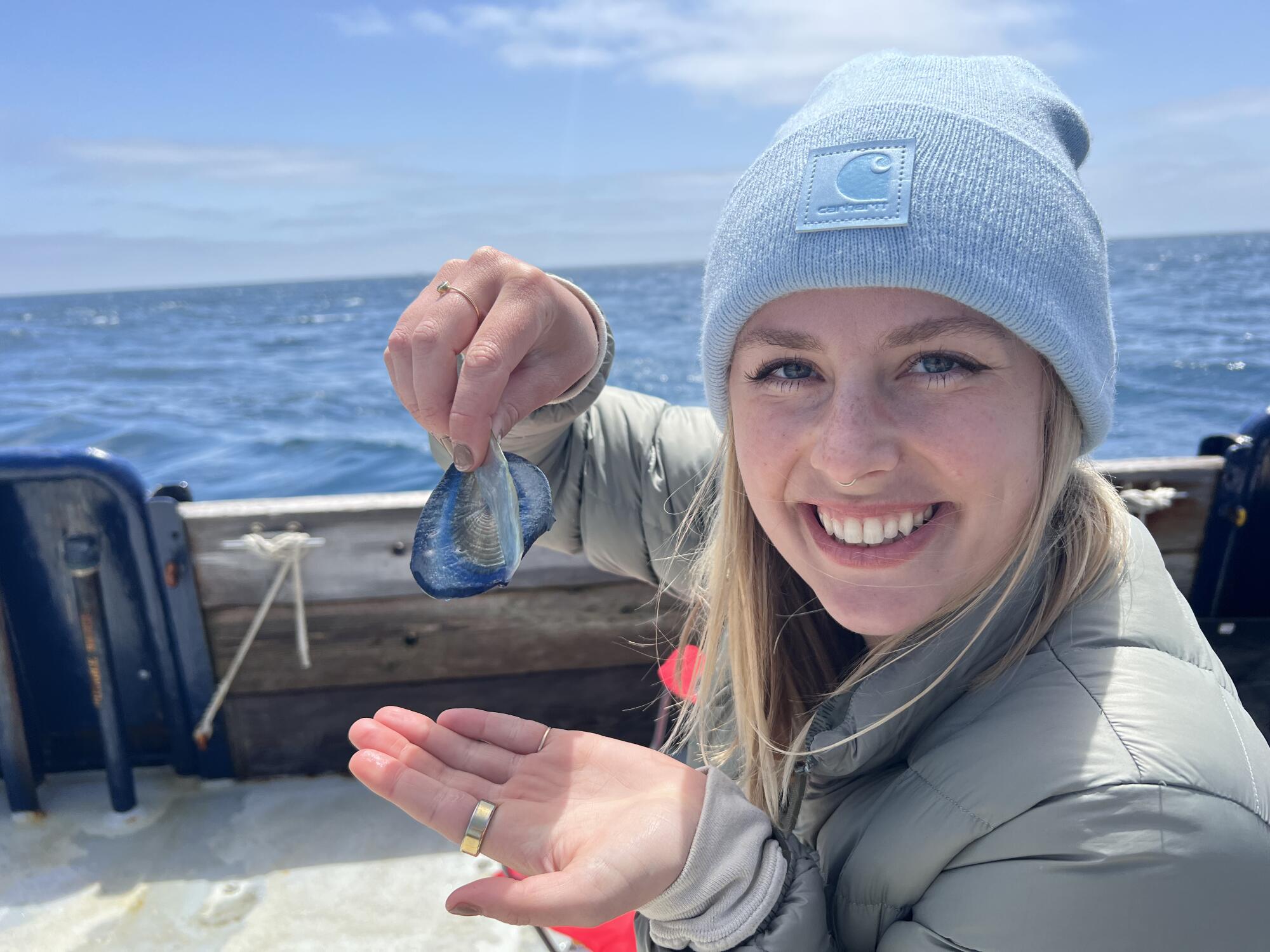
Anya Stajner, a PhD student at Scripps, collected by-the-wind sailors but was unable to keep them alive in a lab. “Rearing gelatinous organisms is pretty difficult,” she said.
“I was able to actually collect some of those medusae last year during the bloom, but rearing gelatinous organisms is pretty difficult,” Stajner said. The organisms died in the lab.
Stajner left May 1 on an eight-day expedition to sample velella at multiple points along the Santa Lucia Bank and Escarpment in the Channel Islands, with the goal of getting “a better idea of their role in the local ecosystem and trying to understand what these big blooms mean,” she said.
-

 Politics1 week ago
Politics1 week agoColumbia University’s policy-making senate votes for resolution calling to investigate school’s leadership
-

 News1 week ago
News1 week agoBoth sides prepare as Florida's six-week abortion ban is set to take effect Wednesday
-

 News1 week ago
News1 week agoPro-Palestinian campus protesters face looming deadlines and risk of arrest
-

 Politics1 week ago
Politics1 week agoRepublican makes major announcement in push to grow GOP support from once-solid Dem voting bloc
-

 World1 week ago
World1 week agoBrussels, my love? MEPs check out of Strasbourg after 5 eventful years
-

 Politics1 week ago
Politics1 week agoGOP Rep. Bill Posey won't seek re-election, endorses former Florida Senate President as replacement
-

 Politics1 week ago
Politics1 week agoHouse Republicans brace for spring legislative sprint with one less GOP vote
-

 World1 week ago
World1 week agoAt least four dead in US after dozens of tornadoes rip through Oklahoma


